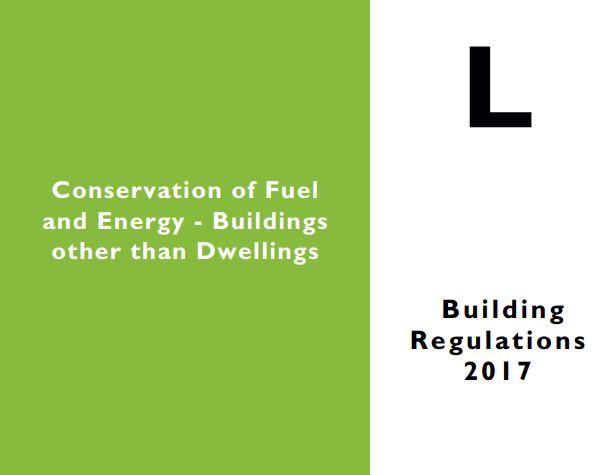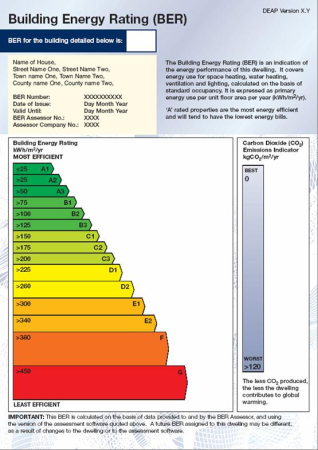Info

Energy Plan for a New Build
Compliance with Part L of the 2011 building regulations is required for a new build. Part L refers to the requirements regarding conservation of fuel and energy for dwellings are laid out in Part L of the Second Schedule to the Building Regulations 1997 (S.I. No. 497 of 1997) as amended by the Building Regulations (Part L Amendment) Regulations 2011 (S.I. No. 259 of 2011).
-
Minimum U values for floors, walls and roof. A high U value indicates a low thermal performance of the building, whereas a low U value indicates high levels of insulation.
-
10kWh/M²/Annum from a renewable source for space and DHW or 4kWh/m²/annum from electrical (PV panels).
-
Air tightness of 7 Air Changes per Hour (ACH)…TESTED.
-
Carbon Performance coefficient at 46% of 1990 levels.
-
Energy Performance coefficient at 40% of 1990 levels.
-
These are NOT options there requirements, verified through the DEAP software used for a Building Energy Rating (BER).

Steps for a New Build Energy Plan
What’s Needed?
- Building Energy Rating (BER) assessment to demonstrate by design that you will meet these requirements BEFORE you start to build.
- Insulation plan / renewable plan / Air tightness & Heat Recovery Ventilation (HRV) plan.
Who Needs it?
- Everyone involved in the new build process: Architect/Engineer, Self builders (project manager), Builders.



Building Energy Rating (BER)
What is a BER?
- A Building Energy Rating or BER is an energy label with accompanying advisory report for homes. The rating is a simple A to G scale. A-rated homes are the most energy efficient and will tend to have the lowest energy bills. A BER makes the energy performance of a home visible to prospective buyers and tenants allowing them to take energy performance into consideration in their purchase or rental decision. The Advisory Report identifies potential energy performance improvements that could lead to better comfort levels, reduced energy use and costs. A BER is valid for up to 10 years provided that there is no material change to the home that could affect the energy performance. A Provisional BER, derived from the plans for an as yet un-built home, has a maximum validity of 2 years.
Who Needs a BER?
- An owner must provide a BER to prospective buyers or tenants when a home is offered for sale or rent. There are exemptions for certain building categories e.g. protected structures and temporary buildings. A homeowner must obtain a BER before a new home is occupied for the first time regardless of whether it is offered for sale or rent. BER details must be included on advertisements when a home is offered for sale or rent.
How is a BER calculated?
- A BER is based on the calculated energy performance and associated carbon dioxide emissions for the provision of space heating, ventilation, water heating and lighting under standardised operating conditions. The characteristics of the major components of the home including dimensions, orientation, insulation, and space and hot water system efficiencies are used in the calculation. The BER is not dependent on current occupant behaviour. The energy performance is expressed as: (a) Primary energy use per unit floor area per year (kWh/m2/yr) represented on an A to G scale; and (b) Associated Carbon Dioxide (CO2) emissions in kgCO2/m2/yr. A BER is only an indication of the energy performance of a home, similar to the concept of a fuel economy (miles per gallon or litres per 100km) rating for a car. A BER does not include electricity used for purposes other than heating, lighting, pumps and fans. Therefore the energy used for electrical appliances such as cookers, fridges, washing machines and TVs is excluded.
Who carries out BERs?
- BERs are published by independent assessors registered with SEAI. To become registered BER assessors must complete an accredited training course, pass a national examination and act in accordance with a Code of Practice published by SEAI. A list of registered BER assessors is available online at www.seai.ie/ber.
How much does a BER cost?
- A person offering a home for sale or rent, or their agent, is required to employ a registered BER assessor to carry out an assessment. There is no set fee and the advice is to shop around for the best value. Make sure to confirm all fees in writing prior to commissioning a BER assessment. BER assessors are charged a levy of €25 to publish a BER assessment for a home on the National BER Register.
What is a Provisional BER?
- New homes offered for sale off plans also require a BER. A provisional BER is issued based upon the design drawings and building specifications. The provisional BER is valid for a maximum of 2 years. When the home is completed, the provisional BER must be replaced by a final BER based on a survey of the completed home supported by the final drawings and building specifications which represent the home as constructed.
Who is responsible for the BER scheme?
- Under the European Union (Energy Performance of Buildings) Regulations 2012 (S.I. 243 of 2012) the Sustainable Energy Authority of Ireland (SEAI) is designated as the Issuing Authority with responsibility for the registration of BER assessors, maintaining the registers of BER assessments, quality assurance, and awareness raising and ongoing management of the BER scheme. Under the same legislation, enforcement of compliance with BER obligations is a matter for local Building Control Authorities.

Home Renovation Incentive Scheme
The Home Renovation Incentive scheme (HRI) was brought in under budget 2014. It provides a tax incentive to carry out renovation or improvements to your home. This comes in the form of a 13.5% tax credit which you can claim back in the two years following the year in which the work is carried out. The SEAI have also just announced that grants that were available for insulation, heating controls upgrade and solar panels WILL continue for the foreseeable future. So how does this tie in with the HRI?
Well, let’s say you spend €20,000 on qualifying home improvements in 2014 and you claim an SEAI grant of say €560 for a heating controls upgrade and €500 for insulation. Total €1,060. You multiple this grant amount by 3 and deduct it from the total spent.
-
€1,060 x 3 = €3,180. €20,000 – €3,180 = €16,820. This amount is subject to the 13.5% HRI scheme
-
€16,820 x 13.5% = €2,270.70. 50% of this can be claimed back as a tax credit in 2015 and the other 50% in 2016
-
€1,060 x 3 = €3,180. €20,000 – €3,180 = €16,820. This amount is subject to the 13.5% HRI scheme
- €16,820 x 13.5% = €2,270.70. 50% of this can be claimed back as a tax credit in 2015 and the other 50% in 2016.
Don’t forget that Bromur Energy will deduct the SEAI insulation grant amount up front from the cost of an insulation upgrade. Also just to confirm that Bromur Energy is a “qualifying contractor”
